Resistive Memory-Switching Behavior in Solution-Processed Trans, trans-1,4-bis-(2-(2-naphthyl)-2-(butoxycarbonyl)-vinyl) Benzene–PVA-Composite-Based Aryl Acrylate on ITO-Coated PET
Abstract
1. Introduction
2. Materials and Methods
2.1. Materials
2.2. Synthesis of PVA Solutions and PVA-2-NVB Composites
2.3. Device Fabrication
2.4. Electrical and Physical Measurements
- The voltages were swept from 0 V toward 10 V, and currents were measured.
- Initially, the current was very small (high resistance), and it increased toward 10 V.
- At +10 V, the device switched to the low-resistance state (LRS). After that, voltages were swept from 10 V to −10 V, and the output current decreased and then increased toward −10 V.
- Afterwards, voltages were swept from −10 V toward 0 V. At −10 V, the current started decreasing toward 0 V. It was at the minimum value (high-resistance state).
3. Results
3.1. Structural and Thermogravimetric Analysis
3.2. Electrical Characterization: Basic Analysis of I–V Characteristic
3.3. Analysis of Hysteresis in the I–V Characteristic
3.4. Analysis of Capacitive Effect and Negative Differential Resistance (NDR)
3.5. Possible Charge Transport Mechanisms in the Resistive Device


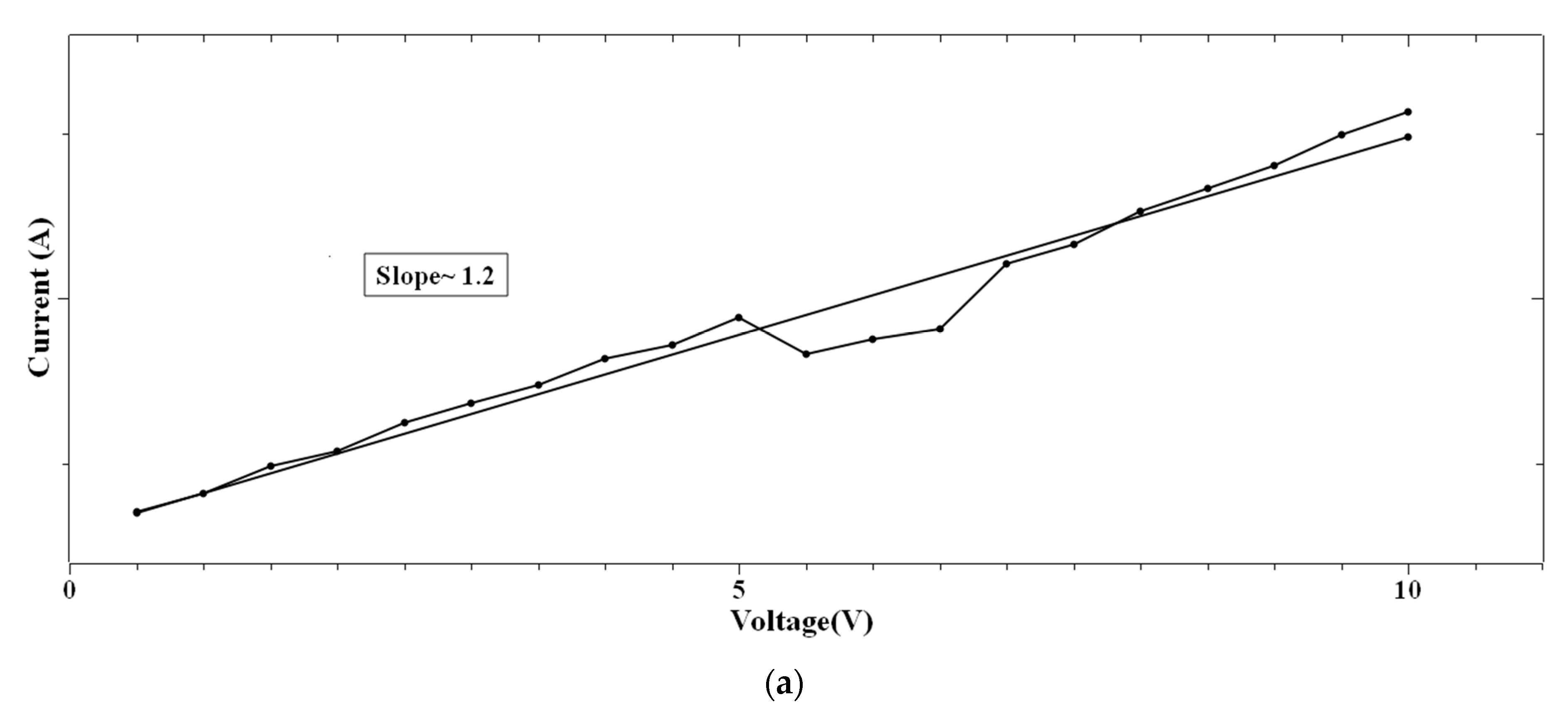

3.6. Possible Model for Resistive Switching Device
4. Conclusions
Author Contributions
Funding
Institutional Review Board Statement
Data Availability Statement
Acknowledgments
Conflicts of Interest
References
- Pelka, J.; Baldi, L. More-than-Moore Technologies and Applications. Nanoelectron. Mater. Devices Appl. 2017, 53–72. [Google Scholar] [CrossRef]
- Wang, X.; Liu, Z.; Zhang, T. Flexible sensing electronics for wearable/attachable health monitoring. Small 2017, 13, 1602790. [Google Scholar] [CrossRef]
- Liu, Y.; Pharr, M.; Salvatore, G.A. Lab-on-skin: A review of flexible and stretchable electronics for wearable health monitoring. ACS Nano 2017, 11, 9614. [Google Scholar] [CrossRef]
- Lee, S.M.; Kwon, J.H.; Kwon, S.; Choi, K.C. A review of flexible OLEDs toward highly durable unusual displays. IEEE Trans. Electron Devices 2017, 64, 1922. [Google Scholar] [CrossRef]
- Gao, S.; Wu, X.; Ma, H.; Robertson, J.; Nathan, A. Ultrathin Multifunctional Graphene-PVDF Layers for Multidimensional Touch Interactivity for Flexible Displays. ACS Appl. Mater. Interfaces 2017, 9, 18410. [Google Scholar] [CrossRef]
- Singh RSingh, E.; Nalwa, H.S. Inkjet printed nanomaterial based flexible radio frequency identification (RFID) tag sensors for the internet of nano things. RSC Adv. 2017, 7, 48597. [Google Scholar] [CrossRef]
- Beck, A.; Bednorz, J.; Gerber, C.; Rossel, C.; Widmer, D. Reproducible switching effect in thin oxide films for memory applications. Appl. Phys. Lett. 2000, 77, 139. [Google Scholar] [CrossRef]
- Gallagher, W.J.; Parkin, S.S. Development of the magnetic tunnel junction MRAM at IBM: From first junctions to a 16-Mb MRAM demonstrator chip. IBM J. Res. Dev. 2006, 50, 5. [Google Scholar] [CrossRef]
- Raoux, S.; Burr, G.W.; Breitwisch, M.J.; Rettner, C.T.; Chen, Y.-C.; Shelby, R.M.; Salinga, M.; Krebs, D.; Chen, S.-H.; Lung, H.-L. Phase-change random access memory: A scalable technology. IBM J. Res. Dev. 2008, 52, 465. [Google Scholar] [CrossRef]
- Meijer, G.I. Who wins the nonvolatile memory race? Science 2008, 319, 1625. [Google Scholar] [CrossRef]
- Lu, W.; Lieber, C.M. Nanoelectronics from the bottom up. Nat. Mater. 2007, 6, 841. [Google Scholar] [CrossRef]
- Hickmott, T.W. Low-frequency negative resistance in thin anodic oxide films. J. Appl. Phys. 1962, 33, 2669. [Google Scholar] [CrossRef]
- Poon, C.T.; Wu, D.; Lam, W.H.; Yam, V.W.W. A solution-processable donor–acceptor compound containing boron (III) centers for small-molecule-based high-performance ternary electronic memory devices. Angew. Chem. Int. Ed. 2015, 54, 10569. [Google Scholar] [CrossRef]
- Li, Y.; Zhang, C.; Gu, P.; Wang, Z.; Li, Z.; Li, H.; Lu, J.; Zhang, Q. Nonvolatile tri-state resistive memory behavior of a stable pyrene-fused N-heteroacene with ten linearly-annulated rings. Chem. Eur. J. 2018, 24, 7845. [Google Scholar] [CrossRef]
- Zhang, Q.; He, J.; Zhuang, H.; Li, H.; Li, N.; Xu, Q.; Chen, D.; Lu, J. Rational design of small molecules to implement organic quaternary memory devices. Adv. Funct. Mater. 2016, 26, 146. [Google Scholar] [CrossRef]
- Miao, S.; Zhu, Y.; Bao, Q.; Li, H.; Li, N.; Ji, S.; Xu, Q.; Lu, J.; Wang, L. Solution-processed small molecule donor/acceptor blends for electrical memory devices with fine-tunable storage performance. J. Phys. Chem. C 2014, 118, 2154. [Google Scholar] [CrossRef]
- Zhu, F.; Zhang, Q.; Zhou, J.; Li, H.; Lu, J. Tuning the microstructure of donor/acceptor blend films to achieve high-performance ternary data-storage devices. J. Phys. Chem. C 2019, 123, 12154. [Google Scholar] [CrossRef]
- Bozano, L.D.; Kean, B.W.; Deline, V.R.; Salem, J.R.; Scott, J.C. Mechanism for bistability in organic memory elements. Appl. Phys. Lett. 2004, 84, 607. [Google Scholar] [CrossRef]
- Ma, L.; Pyo, S.; Ouyang, J.; Xu, Q.; Yang, Y. Nonvolatile electrical bistability of organic/metal-nanocluster/organic system. Appl. Phys. Lett. 2003, 82, 1419. [Google Scholar] [CrossRef]
- Lin, W.P.; Liu, S.J.; Gong, T.; Zhao, Q.; Huang, W. Polymer-based resistive memory materials and devices. Adv. Mater. 2014, 26, 570. [Google Scholar] [CrossRef]
- Liu, S.J.; Wang, P.; Zhao, Q.; Yang, H.Y.; Wong, J.; Sun, H.B.; Dong, X.; Lin, W.; Huang, W. Single polymer-based ternary electronic memory material and device. Adv. Mater. 2012, 24, 2901. [Google Scholar] [CrossRef] [PubMed]
- Zhuang, H.; Xu, X.; Liu, Y.; Zhou, Q.; Xu, X.; Li, H.; Xu, Q.; Li, N.; Lu, J.; Wang, L. Dual-mechanism-controlled ternary memory devices fabricated by random copolymers with pendent carbazole and nitro-azobenzene. J. Phys. Chem. C 2012, 116, 25546. [Google Scholar] [CrossRef]
- Zhang, B.; Fan, F.; Xue, W.; Liu, G.; Fu, Y.; Zhuang, X.; Xu, X.-H.; Gu, J.; Li, R.-W.; Chen, Y. Redox gated polymer memristive processing memory unit. Nat. Commun. 2019, 10, 736. [Google Scholar] [CrossRef] [PubMed]
- Lai, Y.C.; Hsu, F.C.; Chen, J.Y.; He, J.H.; Chang, T.C.; Hsieh, Y.P.; Lin, T.; Yang, Y.; Chen, Y. Transferable and flexible label-like macromolecular memory on arbitrary substrates with high performance and a facile methodology. Adv. Mater. 2013, 25, 2733. [Google Scholar] [CrossRef] [PubMed]
- Qi, S.; Iida, H.; Liu, L.; Irle, S.; Hu, W.; Yashima, E. Electrical switching behavior of a [60] fullerene-based molecular wire encapsulated in a syndiotactic poly (methyl methacrylate) helical cavity. Angew. Chem. 2013, 125, 1083. [Google Scholar] [CrossRef]
- Sarkar, P.; Das, B.K.; Chakraborty, D.; Muthamma, K. Carbohelicenes and thiahelicene from phthalaldehydes through Perkin approach. J. Mol. Struct. 2019, 1195, 309. [Google Scholar] [CrossRef]
- Aziz, S.B. Modifying poly (vinyl alcohol)(PVA) from insulator to small-bandgap polymer: A novel approach for organic solar cells and optoelectronic devices. J. Electron. Mater. 2016, 45, 736. [Google Scholar] [CrossRef]
- Abdullah, O.G.; Saleem, S.A. Effect of copper sulfide nanoparticles on the optical and electrical behavior of poly (vinyl alcohol) films. J. Electron. Mater. 2016, 45, 5910. [Google Scholar] [CrossRef]
- Abdullah, O.G.; Aziz, S.B.; Rasheed, M.A. Structural and optical characterization of PVA: KMnO4 based solid polymer electrolyte. Results Phys. 2016, 6, 1103. [Google Scholar] [CrossRef]
- Cullity, B.; Stock, S. Microcomputed Tomography: Methodology and Applications; CRC Press: Upper Saddle River, NJ, USA, 2001; p. 388. [Google Scholar]
- Shokralla, S.A.; Al-Muaikel, N. Thermal properties of epoxy (DGEBA)/phenolic resin (NOVOLAC) blends. Arab. J. Sci. Eng. 2010, 35, 7–14. [Google Scholar]
- Valov, I.; Linn, E.; Tappertzhofen, S.; Schmelzer, S.; van den Hurk, J.; Lentz, F.; Waser, R. Nanobatteries in redox-based resistive switches require extension of memristor theory. Nat. Commun. 2013, 4, 1771. [Google Scholar] [CrossRef]
- Zhou, G.; Ren, Z.; Sun, B.; Wu, J.; Zou, Z.; Zheng, S.; Wang, L.; Duan, S.; Song, Q. Capacitive effect: An original of the resistive switching memory. Nano Energy 2020, 68, 104386. [Google Scholar] [CrossRef]
- Kamble, G.U.; Patil, A.P.; Kamat, R.K.; Kim, J.H.; Dongale, T.D. Promising Materials and Synthesis Methods for Resistive Switching Memory Devices: A Status Review. ACS Appl. Electron. Mater. 2023, 5, 2454. [Google Scholar] [CrossRef]
- Zhou, G.; Ji, X.; Li, J.; Zhou, F.; Dong, Z.; Yan, B.; Sun, B.; Wang, W.; Hu, X.; Song, Q. Second-order associative memory circuit hardware implemented by the evolution from battery-like capacitance to resistive switching memory. Iscience 2022, 25, 105240. [Google Scholar] [CrossRef] [PubMed]
- Majumdar, H.S.; Bandyopadhyay, A.; Bolognesi, A.; Pal, A.J. Erratum:“Memory device applications of a conjugated polymer: Role of space charges. J. Appl. Phys. 2002, 91, 2433. [Google Scholar] [CrossRef]
- Sun, B.; Xiao, M.; Zhou, G.; Ren, Z.; Zhou, Y.N.; Wu, Y.A. Non–zero-crossing current-voltage hysteresis behavior in memristive system. Mater. Today Adv. 2020, 6, 100056. [Google Scholar] [CrossRef]
- Zhu, S.; Zhou, G.; Yuan, W.; Mao, S.; Yang, F.; Fu, G.; Sun, B. Non-zero-crossing current-voltage hysteresis behavior induced by capacitive effects in bio-memristor. J. Colloid Interface Sci. 2020, 560, 565. [Google Scholar] [CrossRef]
- Zheng, L.; Sun, B.; Mao, S.; Zhu, S.; Zheng, P.; Zhang, Y.; Lei, M.; Zhao, Y. Metal ions redox induced repeatable nonvolatile resistive switching memory behavior in biomaterials. ACS Appl. Bio Mater. 2018, 1, 496. [Google Scholar] [CrossRef]
- Wei, L.; Sun, B.; Zhao, W.; Li, H.; Chen, P. Light regulated I–V hysteresis loop of Ag/BiFeO3/FTO thin film. Appl. Surf. Sci. 2017, 393, 325. [Google Scholar] [CrossRef]
- Nguyen, P.D.; Nguyen, T.C.; Hossain, F.M.; Huynh, D.H.; Evans, R.; Skafidas, E. Negative differential resistance effect in planar graphene nanoribbon break junctions. Nanoscale 2015, 7, 289. [Google Scholar] [CrossRef]
- Wang, B.; Zang, C. Negative differential resistance effect induced by bulk and interface defect states in Pt/CeO2-x/Pt resistive memory devices. Vacuum 2022, 202, 111171. [Google Scholar] [CrossRef]
- Chen, Y.T.; Santiago, S.R.M.S.; Sharma, S.; Wu, C.B.; Chou, C.L.; Chang, S.H.; Chiu, K.-C.; Shen, J.-L. Resistive switching accompanied by negative differential resistance in cysteine-functionalized WS2 quantum dots toward nonvolatile memory devices. ACS Appl. Nano Mater. 2022, 5, 2250. [Google Scholar] [CrossRef]
- Park, M.J.; Lee, J.S. Zeolitic-imidazole framework thin film-based flexible resistive switching memory. RSC Adv. 2017, 7, 21045. [Google Scholar] [CrossRef]
- Awais, M.N.; Jo, J.-D.; Choi, K.H. Negative differential resistive switching in poly (3, 4-ethylenedioxythiophene): Poly (styrenesulfonate) thin film through electrohydrodynamic atomization. Appl. Phys. A 2013, 113, 89. [Google Scholar] [CrossRef]
- Hamann, C.; Burghardt, H.; Frauenheim, T. Electrical Conduction Mechanisms in Solids; VEB Deutscher Verlag der Wissenschaften: Berlin, Germany, 1990. [Google Scholar]
- Mott, N.F.; Gurney, R.W. Electronic Processes in Ionic Crystals, 2nd ed.; Mott, N.F., Gurney, R.W., Eds.; Clarendon Press: Oxford, UK, 1940. [Google Scholar]
- Li, W.; Zhu, H.; Sun, T.; Qu, W.; Fan, X.; Gao, Z.; Shi, W.; Wei, B. High On/Off Ratio Organic Resistive Switching Memory Based on Carbazolyl Dicyanobenzene and a Polymer Composite. J. Phys. Chem. 2022, 126, 12897–12905. [Google Scholar] [CrossRef]
- Guo, B.; Sun, B.; Hou, W.; Chen, Y.; Zhu, S.; Mao, S.; Zheng, L.; Lei, M.; Fu, G. A sustainable resistive switching memory device based on organic keratin extracted from hair. RSC Adv. 2019, 9, 12436. [Google Scholar] [CrossRef] [PubMed]
- Sun, T.; Shi, H.; Gao, S.; Zhou, Z.; Yu, Z.; Guo, W.; Li, H.; Zhang, F.; Xu, Z.; Zhang, X. Stable Resistive Switching in ZnO/PVA: MoS2 Bilayer Memristor. Nanomaterials 2022, 12, 1977. [Google Scholar] [CrossRef] [PubMed]
- Wu, W.; Han, S.-T.; Venkatesh, S.; Sun, Q.; Peng, H.; Zhou, Y.; Yeung, C.; Li, R.K.Y.; Roy, V.A.L. Biodegradable skin-inspired nonvolatile resistive switching memory based on gold nanoparticles embedded alkali lignin. Org. Electron. 2018, 59, 382–388. [Google Scholar] [CrossRef]
- Hota, M.K.; Bera, M.K.; Kundu, B.; Kundu, S.C.; Maiti, C.K. A natural silk fibroin protein-based transparent bio-memristor. Adv. Funct. Mater. 2012, 22, 4493. [Google Scholar] [CrossRef]
- Ge, L.; Xuan, W.; Liu, S.; Huang, S.; Wang, X.; Dong, S.; Jin, H.; Luo, J. Biomaterial gelatin film based crossbar structure resistive switching devices. IEEE Trans. Nanotech. 2018, 17, 78–83. [Google Scholar] [CrossRef]
- Oh, S.I.; Rani, J.R.; Hong, S.M.; Jang, J.H. Self-rectifying bipolar resistive switching memory based on an iron oxide and graphene oxide hybrid. Nanoscale 2017, 9, 15314. [Google Scholar] [CrossRef] [PubMed]
- Li, L.; Wen, D. Memristic characteristics from bistable to tristable memory with controllable charge trap carbon nanotubes. Nanomaterials 2018, 8, 114. [Google Scholar] [CrossRef] [PubMed]
- Yu, X.; Shen, T.; Zhu, C.; Zeng, Q.; Yu, A.; Liu, S.; Yi, R.; Weng, Z.; Zhan, Y.; Hou, X.; et al. Memory Devices via unipolar resistive switching in symmetric organic–inorganic perovskite nanoscale heterolayers. ACS Nano. 2020, 3, 11889. [Google Scholar] [CrossRef]
- Yan, K.; Chen, B.; Hu, H.; Chen, S.; Dong, B.; Gao, X.; Xiao, X.; Zhou, J.; Zou, D. irst Fiber-Shaped Non-Volatile Memory Device Based on Hybrid Organic-Inorganic Perovskite. Adv. Electron. Mater. 2016, 2, 1600160. [Google Scholar] [CrossRef]
- Zeng, F.; Tan, Y.; Hu, W.; Tang, X.; Luo, Z.; Huang, Q.; Guo, Y.; Zhang, H.; Yin, H.; Feng, J.; et al. Impact of Hydroiodic Acid on Resistive Switching Performance of Lead-Free Cs3Cu2I5 Perovskite Memory. J. Phys. Chem. Lett. 2021, 12, 1973. [Google Scholar] [CrossRef]
- Wu, X.; Yu, H.; Cao, J. Unraveling the origin of resistive switching behavior in organolead halide perovskite based memory devices. AIP Advances 2020, 10, 085202. [Google Scholar] [CrossRef]
- Krishnan, K.; Aono, M.; Tsuruoka, T. Thermally stable resistive switching of a polyvinyl alcohol-based atomic switch. J. Mater. Chem. C 2018, 6, 6460. [Google Scholar] [CrossRef]
- Cho, B.; Yun, J.M.; Song, S.; Ji, Y.; Kim, D.Y.; Lee, T. Direct observation of Ag filamentary paths in organic resistive memory devices. Adv. Funct. Mater. 2011, 21, 3976. [Google Scholar] [CrossRef]
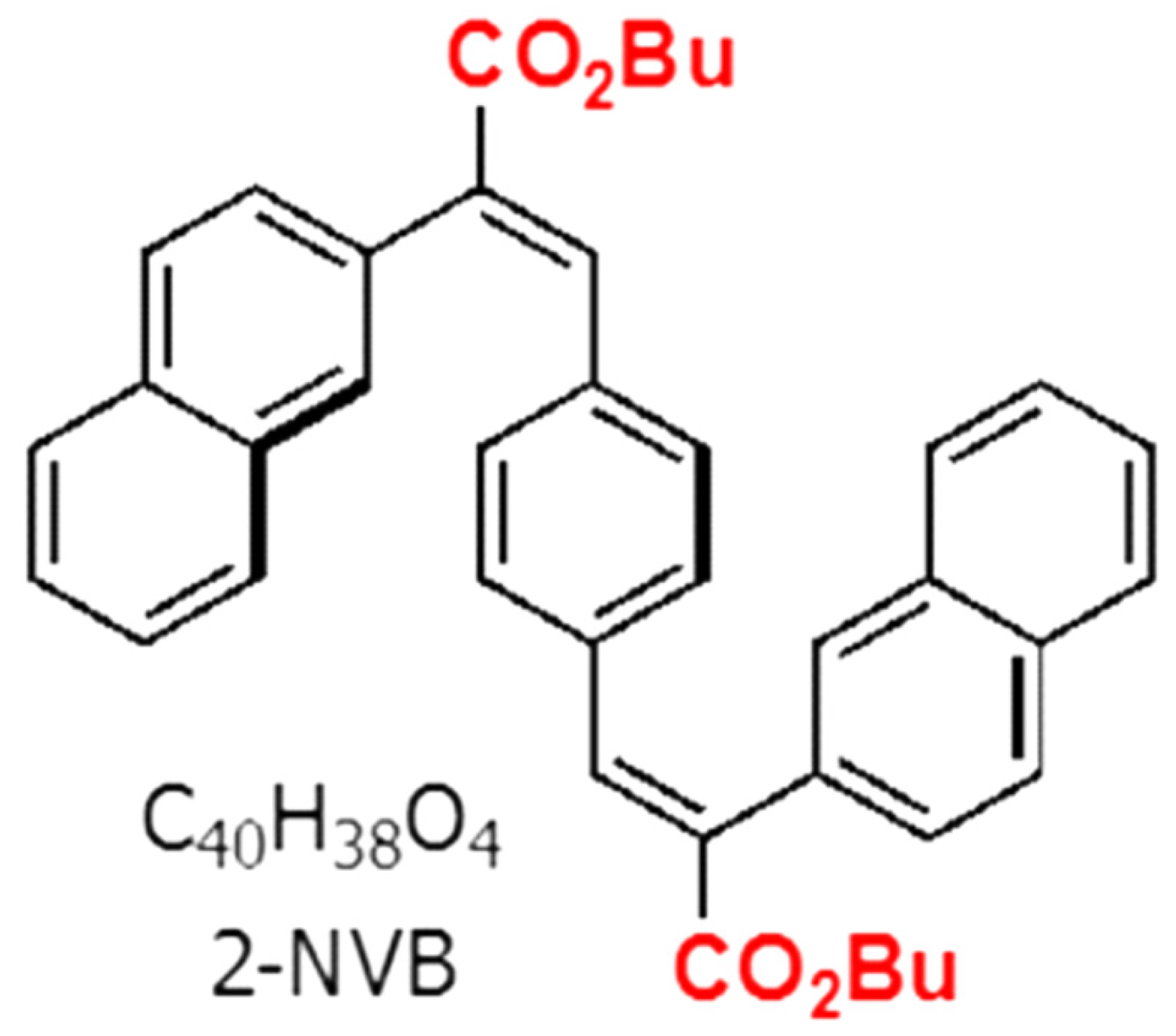
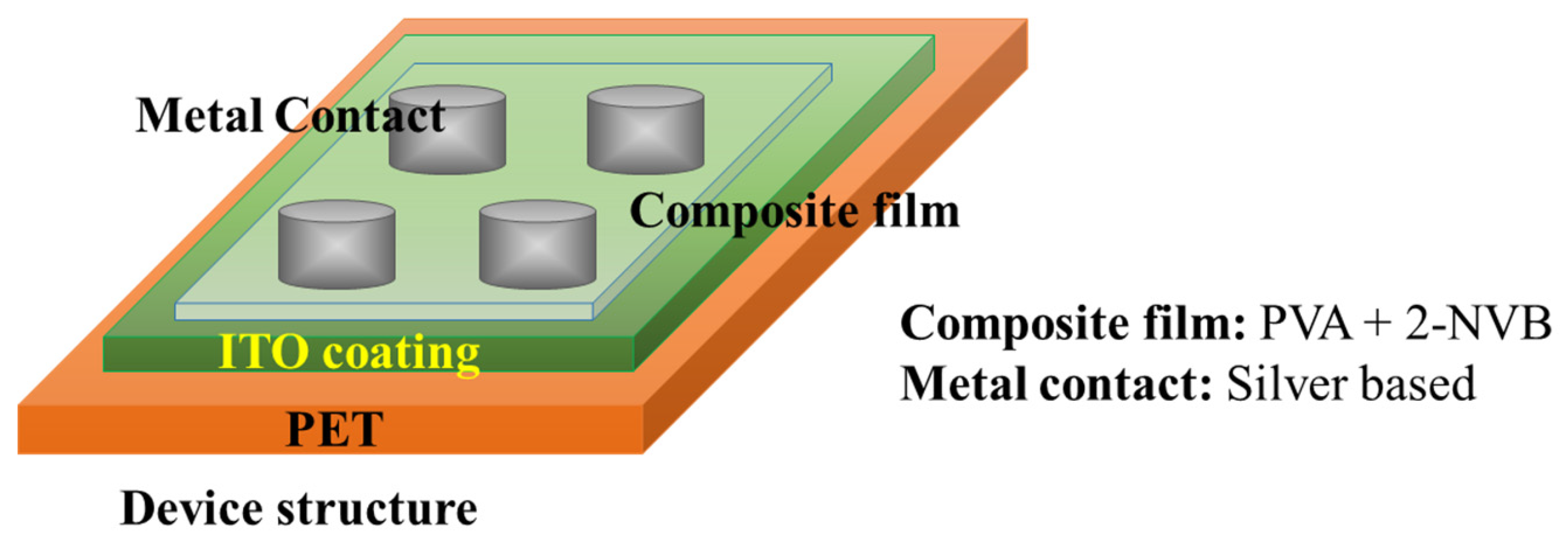
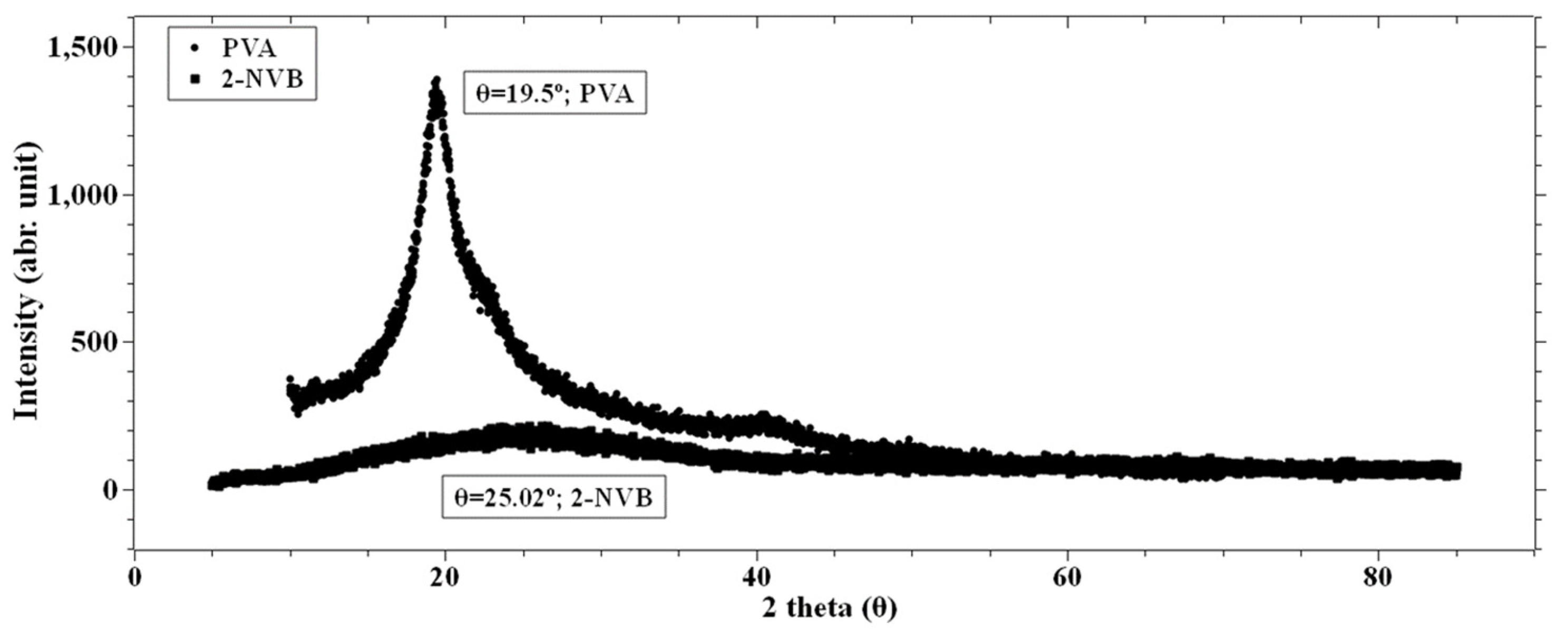

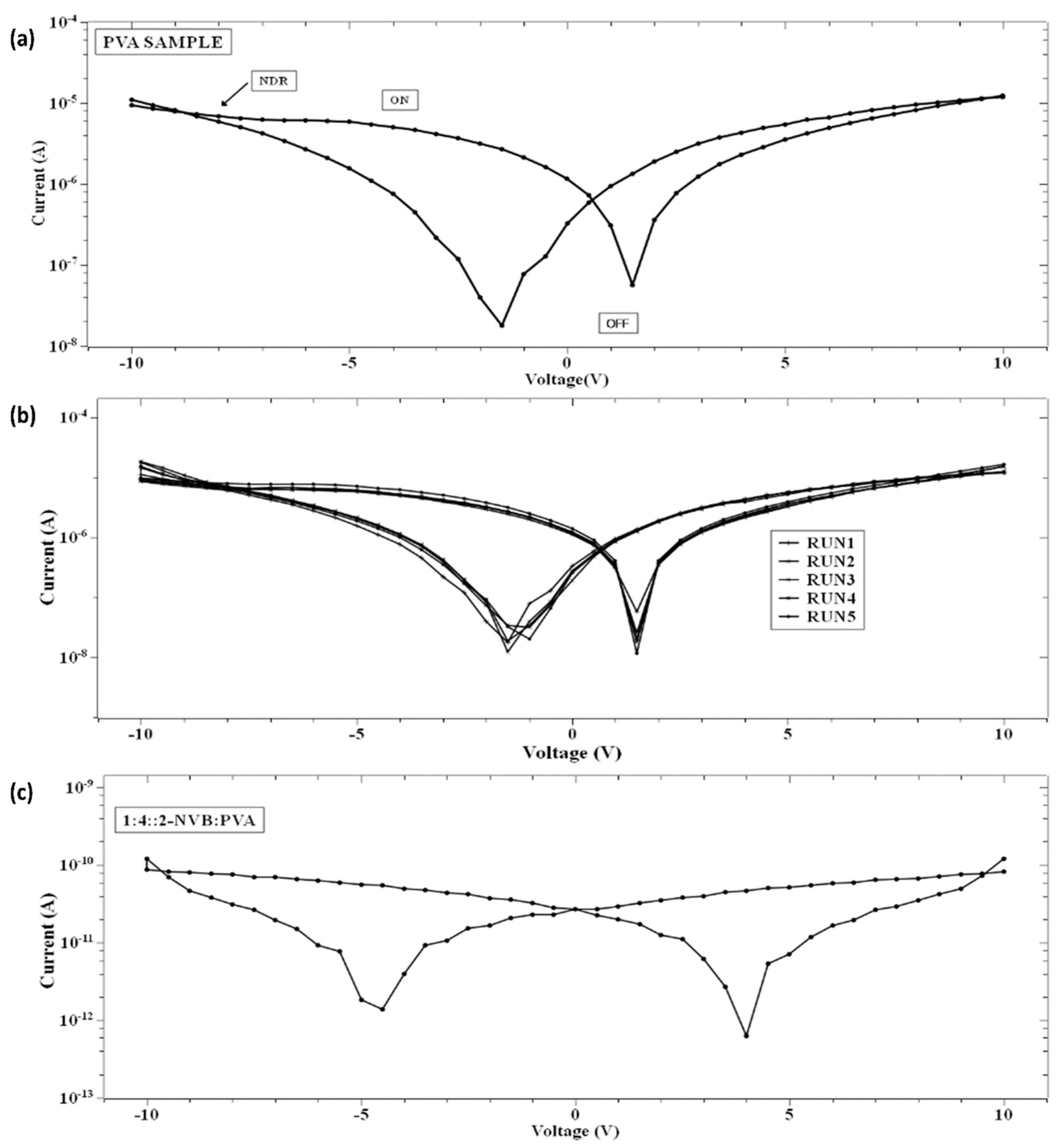
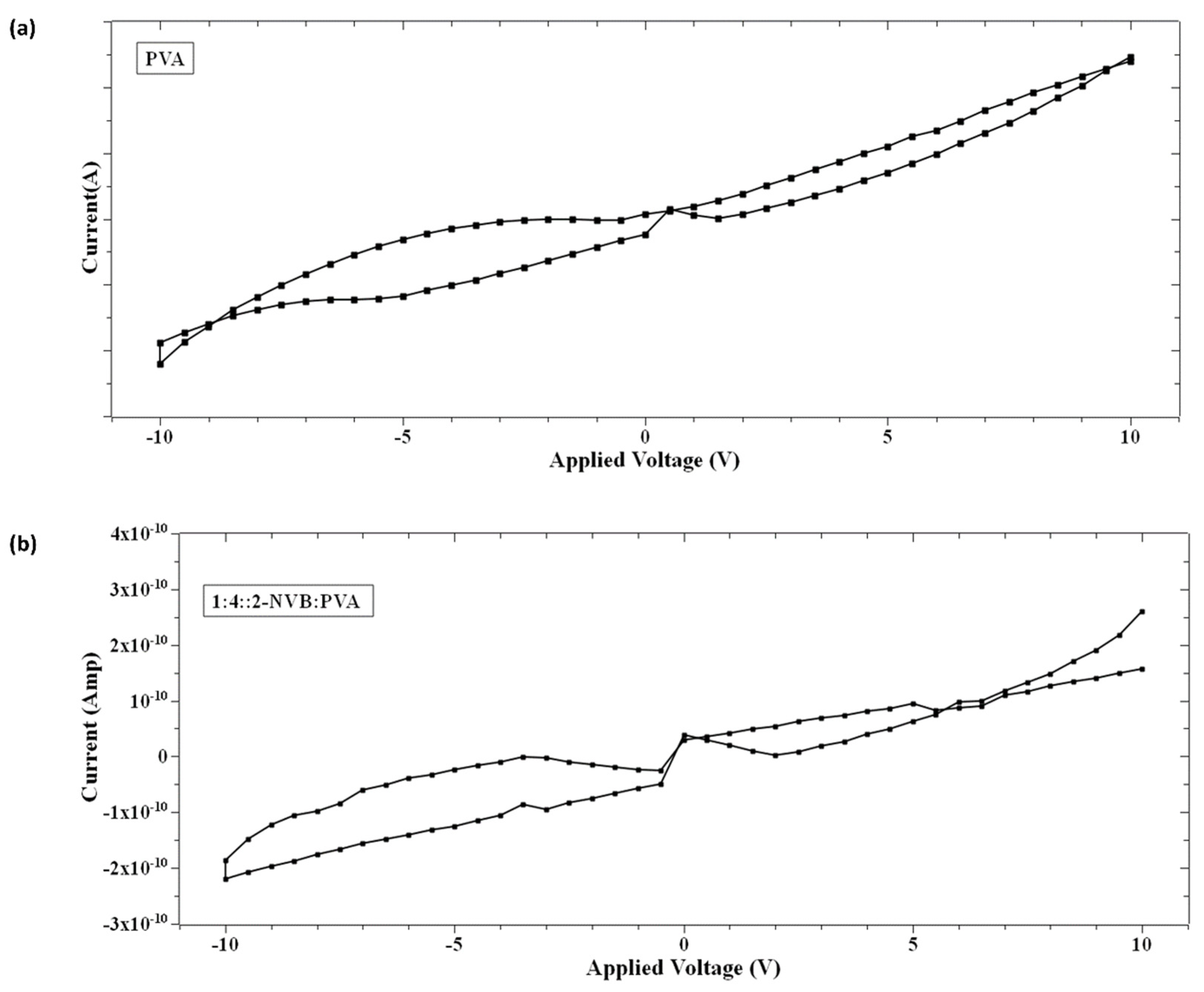
| Type | Advantages | Disadvantages |
|---|---|---|
| ReRAM | - Simple architecture - High device density - Composed of simple and versatile materials | - Forming voltage - High write latency, sneak path - Non-uniformity |
| PCM | - Well established - Stable performance | - Noise and reliability issues - Large power requirement while switching |
| STTRAM | - Good performance - Novel mechanisms - Well-established phenomenon | - Power stability issues - Write failure and read disturb |
| FeFET | - Simple one-transistor structure - Good endurance and scalability - Low field requirements | - Short memory retention - Suffers from charge trapping - Depolarization field |
| Compound | Glass Transition Temperature (Tg) (°C) | Onset Temperature (To) (°C) | Endset Temperature (Te) (°C) | Melting Point (°C) | Enthalpy (J/g) |
|---|---|---|---|---|---|
| PVA | 90.41 | 213.19 | 227.11 | 222.23 | −47.24 |
| 1:4::2-NVB:PVA | 105.44 | 209.22 | 223.57 | 218.77 | −35.75 |
| Sample Name | Type of Applied Voltage | Voc (V) | Isc |
|---|---|---|---|
| PVA | Positive biasing | +1 | −1.3 μA |
| Negative biasing | −1.06 | 0.33 μA | |
| 1:4:: 2-NVB:PVA | Positive biasing | 1.5 | −52.5 pA |
| Negative biasing | −3.4 | 23.67 pA |
| Structure | Deposition Technique | ON/OFF Ratio | Sweeping Window | No. of States | Ref. |
|---|---|---|---|---|---|
| ITO/P3HT:4CzIPN or 2CzPN/Al | Spin coating | 105 | −8 V to 8 V | 2 | [48] |
| Ag/keratin/ITO | Solution processing | ~104 | −6 V to +6 V | 2 | [49] |
| Ag/ZnO/PVA:MoS2/ITO | Sputtering, spin coating | ~104 | −3 V to +3 V | 2 | [50] |
| Al/Au NPs:lignin/Al | Spin coating | ~104 | −6 V to 5 V | 2 | [51] |
| Al/silk fibroin/ITO | Spin coating | ~1 | −15 V to 15 V | 2 | [52] |
| Al/gelatin/ITO | Spin coating | ~104 | −6 V to +6 V | 2 | [53] |
| Au/Ni/FeOx-GO/Si3N4/n+-Si | PECVD, spin coating | ~104 | −10 V to 10 V | 2 | [54] |
| ITO/PMMA:MWCNT-COOH/Ni | Spin coating | ~107 | −6 V to +6 V | 3 | [55] |
| Ag/Bphen/MAPbBr3/PEDOT:PSS/ITO | Spin coating | 80 | 0 V to +6 V | 1 | [56] |
| Ti/TiO2/CH3NH3Pb ClXI3-X/Au | Coating | 20 | −5 V to +5 V | 2 | [57] |
| Al/Cs 3Cu 2I5/ITO | Spin coating | 65 | −1 V to 1 V | 2 | [58] |
| ITO/PEI/CH3NH3PbI3/PEI/metal | Coating | 20 | −1 V to 1 V | 2 | [59] |
| Ag/2-NVB-PVA/ITO | Spin coating | ~102 | −10 V to +10 V | 2 | Present work |
Disclaimer/Publisher’s Note: The statements, opinions and data contained in all publications are solely those of the individual author(s) and contributor(s) and not of MDPI and/or the editor(s). MDPI and/or the editor(s) disclaim responsibility for any injury to people or property resulting from any ideas, methods, instructions or products referred to in the content. |
© 2024 by the authors. Licensee MDPI, Basel, Switzerland. This article is an open access article distributed under the terms and conditions of the Creative Commons Attribution (CC BY) license (https://creativecommons.org/licenses/by/4.0/).
Share and Cite
Kamath, R.; Sarkar, P.; Melanthota, S.K.; Biswas, R.; Mazumder, N.; De, S. Resistive Memory-Switching Behavior in Solution-Processed Trans, trans-1,4-bis-(2-(2-naphthyl)-2-(butoxycarbonyl)-vinyl) Benzene–PVA-Composite-Based Aryl Acrylate on ITO-Coated PET. Polymers 2024, 16, 218. https://doi.org/10.3390/polym16020218
Kamath R, Sarkar P, Melanthota SK, Biswas R, Mazumder N, De S. Resistive Memory-Switching Behavior in Solution-Processed Trans, trans-1,4-bis-(2-(2-naphthyl)-2-(butoxycarbonyl)-vinyl) Benzene–PVA-Composite-Based Aryl Acrylate on ITO-Coated PET. Polymers. 2024; 16(2):218. https://doi.org/10.3390/polym16020218
Chicago/Turabian StyleKamath, Rachana, Parantap Sarkar, Sindhoora Kaniyala Melanthota, Rajib Biswas, Nirmal Mazumder, and Shounak De. 2024. "Resistive Memory-Switching Behavior in Solution-Processed Trans, trans-1,4-bis-(2-(2-naphthyl)-2-(butoxycarbonyl)-vinyl) Benzene–PVA-Composite-Based Aryl Acrylate on ITO-Coated PET" Polymers 16, no. 2: 218. https://doi.org/10.3390/polym16020218
APA StyleKamath, R., Sarkar, P., Melanthota, S. K., Biswas, R., Mazumder, N., & De, S. (2024). Resistive Memory-Switching Behavior in Solution-Processed Trans, trans-1,4-bis-(2-(2-naphthyl)-2-(butoxycarbonyl)-vinyl) Benzene–PVA-Composite-Based Aryl Acrylate on ITO-Coated PET. Polymers, 16(2), 218. https://doi.org/10.3390/polym16020218







